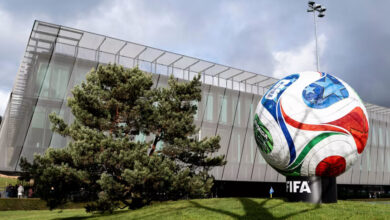In the past several days, two battles have raged in Egypt. One was the national football team’s attempt to qualify for the World Cup; the other was a campaign by advertising companies to exploit that attempt in hopes of grabbing the attention of potential customers.
Disappointment over the first of these is still palpable, but how did the other struggle fare? And what playbooks did advertising companies follow this past week?
“Basically, ‘over-stimulate them until they submit’ was the general tactic of this particular game,” said Nabil Serri, a marketing consultant who’s worked with several multinational companies throughout this career. Serri was referring to the onslaught of Egyptian television and outdoor advertising that preceded the two Egypt-Algeria matches.
The pinnacle of the onslaught was reached during the first of these matches, when computer-generated advertising images crammed television screens, superimposing themselves on the pitch or popping up out of nowhere — often obscuring players as they ran across the field.
“It would be a particularly intense moment in the game and suddenly an advert for water heaters would pop up in the middle of the screen," said disappointed fan Hatem Seoudi.
For those watching the match on satellite channel Al Masriya, the half-time "Stad el-Nil" commentary program was even less subtle. With the presenter occupying only one third of the screen, the remaining space was devoted to a large display panel — bombarding viewers with bright pinks and yellows — pleading for viewers’ attention to the products they advertised.
“It’s not like there was some kind of theme or order to these adverts,” said Serri. “It was just a jumble of utterly unrelated products one after the other, from ceramics to shampoo to real estate. It’s the same on outdoor billboards: all products are tactlessly trying to jump on the ‘support Egypt’ wagon.”
There were also TV adverts featuring ex-Zamalek midfielder Hazem Emam telling viewers about the importance of not having dandruff, while footballer Abu Treika spoke earnestly about the vast sources of calcium to be found in Teama’s cheese spread.
According to Hani Henry, assistant professor and head of the American University in Cairo’s psychology department, there are two mechanisms generally employed by advertisers.
The first is "conditioning," that is, trying to “create a link between an unrelated stimulus [in this case, the football match] to produce a particular response [namely, buying the product],” he explained. “Advertisers use this all the time, by associating, for example, Amr Diab with Pepsi and Nancy Agram with Coca Cola.”
The second of these mechanisms, according to Henry, is suggestibility. “Advertisers know that people are more open to suggestions while in an altered state of consciousness,” said Henry. “And, of course, the emotional circumstances of a football game provide that opportunity.”
Indeed, emotions have run high in Egypt for the past week, with an arguably newfound sense of patriotism uniting people under the umbrella campaign of "ya rab" — a plea to God for victory.
Mobile-phone provider Vodafone, for one, was an outspoken proponent of this particular campaign.
“Our aim was to say out loud what every Egyptian was thinking — sending hopes and prayers to the Egyptian team,” said Vodafone Assistant Brand Manager Omar Eid. He explained that Vodafone had refrained from advertising during the matches because “in the stadium, no one really cares about whose banner is up — everything aside from the game is irrelevant."
For Eid, it all comes down to “who does it with some class and who doesn’t.” Based on this criterion, though, it would seem that — with few exceptions — the Egyptian national team was not the only one to disappoint.




